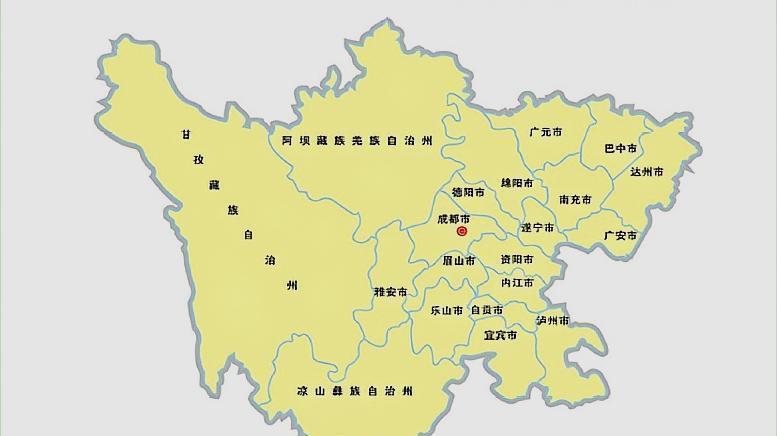Sichuan is one of the largest provinces in the southwest region, but also one of the most important provinces in China, where the economy is developed, the population is large, has the reputation of "the country of heavenly capital", and in the early days of the founding of the country, Sichuan was named as the four major administrative districts: Eastern Sichuan, Western Sichuan, Southern Sichuan, Northern Sichuan, until 1952 was not merged again, so where were the four major administrative districts stationed at that time?

Sichuan has a long history
Sichuan in geography belongs to a large basin, in the Sichuan Basin all year round, Chengdu around the vast Chengdu Plain, the Warring States period, after the Qin conquered the land of Bashu, here has always belonged to the Central Plains Dynasty under the rule, and gradually has the reputation of "the country of heaven", because it is itself a basin structure, resulting in the various regions of Sichuan are closely linked together, can not be styled at all, so Sichuan has always been complete in history.
During the Han Dynasty, when the world was divided into 13 states, Sichuan was Yizhou, the Tang Dynasty was divided into 15 provinces, Sichuan belonged to Jiannan Province, and after the Yuan Dynasty, the provincial system began, which was called Sichuan Province, although Sichuan could not be divided for geographical reasons, but it was also prone to the situation of dividing the regime, that is, the so-called "the world is not chaotic before Shu chaos, the world has been determined Shu is undecided" such a situation. The main reason was that it was very difficult to enter Sichuan at that time.
In history, there have been countless regimes here, such as Shu Han, Cheng Han, Former Shu, Later Shu, Zhang Xianzhong's Daxi regime, etc., the emergence of this series of regimes also indirectly proves the complexity of Sichuan, after the fall of the Qing Dynasty, it has also become a place of warlord chaos, causing great damage to the economy here. During the War of Resistance Against Japanese Aggression, Sichuan suffered heavy casualties due to geographical factors, and the prestige of the Sichuan Army resounded throughout the world.
In modern times, there were also a large number of bandits here, such as Huang Qingyuan. From the fall of the Qing Dynasty to the establishment of New China, in the past 37 years, it has experienced a series of catastrophes, so after the liberation of Sichuan, the first thing our army needs to do is to restore Sichuan's economy, and at the same time began the work of suppressing bandits, at that time many bandits here, relying on geography, had a great impact on our army, and at that time because of limited transportation and communication conditions, so in 1950, in order to comprehensively solve the problem of Sichuan, four major administrative areas were divided.
The administrative map of Sichuan is gradually complete
In the early days of the founding of the People's Republic of China, there were a total of 9 major administrative districts in China, such as the Brigade Anda Branch Office In the Northeast, the Anhui South and Anhui North Bureau Districts in Anhui, and the Northern Jiangsu and Southern Jiangsu Provinces in Jiangsu. And after the establishment of the four major administrative districts,
Chengdu, the capital of Sichuan, became the station of the West Sichuan Branch Office District, Nanchong became the station of the North Sichuan Branch Office District, Luzhou became the station of the South Sichuan Branch Office District, and Beibei became the station of the East Sichuan Branch Office District.
At that time, although Chongqing was a municipality directly under the central government, the surrounding area was still subordinate to the Chuandong Bureau, and after 2 years, the bandits at that time were basically eliminated, and the remaining remnants of the army no longer needed the army and were handed over to the local public security department. Because Sichuan's economy began to recover, the four major administrative districts were not conducive to the lives of the people, so in 1952, the four major administrative districts were abolished, Sichuan Province was established, and the provincial capital Chengdu was established.
However, at this time, the administrative map of Sichuan was not complete, there were 14 municipalities directly under the central government at that time, some municipalities directly under the central government were abolished in 1953, and in 1954 Chongqing was abolished and merged into the administration of Sichuan, becoming a sub-provincial city, in 1955 Xikang Province was abolished, and with the Jinsha River as the boundary, the area west of the Jinsha River was assigned to the Tibet Autonomous Region, and the area east was assigned to Sichuan Province, so the territory of Sichuan was gradually complete. In 1997, Chongqing became a municipality directly under the central government for the third time, and the administrative division of Sichuan was completely formed.